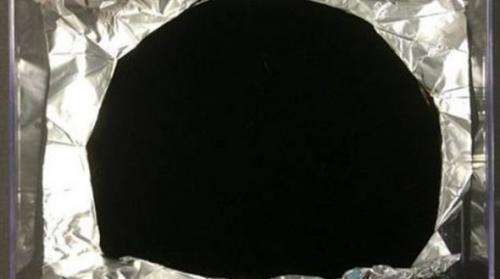July 15, 2014 weblog
Surrey NanoSystems has "super black" material

(Phys.org) —A British company says it has scored a breakthrough in the world's darkest material. Surrey NanoSystems describes its development as not just a black material but super-black. They are calling it Vantablack, and they are singling out its ability to be applied to lightweight, temperature-sensitive structures such as aluminum, absorbing 99.96% of incident radiation; that is, they said, believed to be the highest ever recorded. This coating is mad
e of carbon nanotubes – "each 10,000 times thinner than a human hair," wrote Ian Johnston in The Independent on Sunday. It's not what you see; it's what you don't see. If fact, you see nothing, period. "It is so dark that the human eye cannot understand what it is seeing," wrote Johnston. "Shapes and contours are lost, leaving nothing but an apparent abyss."
The company explains why Vantablack is considered a breakthrough. "The manufacture of `super-black` carbon nanotube-based materials has traditionally required high temperatures, preventing their direct application to sensitive electronics or materials with relatively low melting points. This, along with poor adhesion, prevented their application to critical space and air-borne instrumentation. The two year development and test program was completed in December 2013, during which period Surrey NanoSystems successfully transferred its low-temperature manufacturing process from silicon to aluminum structures and pyroelectric sensors. As part of the program, qualification to European Cooperation on Space Standardization (ECSS) standards was also achieved."
Stephen Westland, professor of color science and technology at Leeds University, said in The Independent, "These new materials, they are pretty much as black as we can get, almost as close to a black hole as we could imagine."
Ryan Whitwam said in Geek.com, "There's demand for something that reflects almost zero light when even a few photons can throw off an experiment."
What are some applications for this material? CNET mentioned its use in electro-optical imaging and target-acquisition systems. "One example of a use for the material is in telescopes to increase the instruments' ability to see very faint stars."
Ben Jensen, the company CTO, detailed what the material could mean in applications. "Vantablack is a major breakthrough by UK industry in the application of nanotechnology to optical instrumentation. For example, it reduces stray-light, improving the ability of sensitive telescopes to see the faintest stars, and allows the use of smaller, lighter sources in space-borne black body calibration systems. Its ultra-low reflectance improves the sensitivity of terrestrial, space and air-borne instrumentation."
The company listed other special characteristics: It has virtually undetectable levels of outgassing and particle fallout, eliminating a key source of contamination in sensitive imaging systems. It withstands launch shock, staging and long-term vibration, and is suitable for coating internal components, such as apertures, baffles, cold shields and Micro Electro Mechanical Systems (MEMS) –type optical sensors.
More information: www.surreynanosystems.com/news/19/
© 2014 Phys.org. All rights reserved.





















